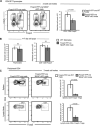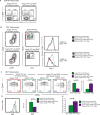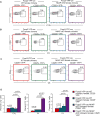Treg-specific deletion of NKAP results in severe, systemic autoimmunity due to peripheral loss of Tregs
- PMID: 29366602
- PMCID: PMC6205721
- DOI: 10.1016/j.jaut.2017.12.013
Treg-specific deletion of NKAP results in severe, systemic autoimmunity due to peripheral loss of Tregs
Abstract
Regulatory T cells are critical for the generation and maintenance of peripheral tolerance. Conditional deletion of the transcriptional repressor NKAP in Tregs using Foxp3-YFP-cre NKAP conditional knockout mice causes aggressive autoimmunity characterized by thymic atrophy, lymphadenopathy, peripheral T cell activation, generation of autoantibodies, immune infiltration into several organs, and crusty skin at 3 weeks of age, similar to that of "scurfy" Foxp3-mutant mice. While Treg development in the thymus proceeds normally in the absence of NKAP, there is a severe loss of thymically-derived Tregs in the periphery. NKAP-deficient Tregs have a recent thymic emigrant phenotype, and are attacked by complement in a cell-intrinsic manner in the periphery. Previously, we demonstrated that NKAP is required for conventional T cell maturation as it prevents complement-mediated attack in the periphery. We now show that Tregs undergo a similar maturation process as conventional T cells, requiring NKAP to acquire complement resistance after thymic egress.
Keywords: Complement; NKAP; Scurfy; Tregs.
Copyright © 2018 Elsevier Ltd. All rights reserved.
Conflict of interest statement
The authors declare no competing financial interests.
Figures





Similar articles
-
The Interaction between NKAP and HDAC3 Is Critical for T Cell Maturation.Immunohorizons. 2019 Aug 6;3(8):352-367. doi: 10.4049/immunohorizons.1900052. Immunohorizons. 2019. PMID: 31387873 Free PMC article.
-
Egress of mature murine regulatory T cells from the thymus requires RelA.J Immunol. 2015 Apr 1;194(7):3020-8. doi: 10.4049/jimmunol.1302756. Epub 2015 Feb 27. J Immunol. 2015. PMID: 25725099
-
Immature recent thymic emigrants are eliminated by complement.J Immunol. 2014 Dec 15;193(12):6005-15. doi: 10.4049/jimmunol.1401871. Epub 2014 Nov 3. J Immunol. 2014. PMID: 25367120 Free PMC article.
-
Development and function of Foxp3(+) regulatory T cells.Nephrology (Carlton). 2016 Feb;21(2):81-5. doi: 10.1111/nep.12652. Nephrology (Carlton). 2016. PMID: 26461175 Review.
-
Induction and maintenance of regulatory T cells by transcription factors and epigenetic modifications.J Autoimmun. 2017 Sep;83:113-121. doi: 10.1016/j.jaut.2017.07.002. Epub 2017 Jul 11. J Autoimmun. 2017. PMID: 28709726 Review.
Cited by
-
Murine T Cell Maturation Entails Protection from MBL2, but Complement Proteins Do Not Drive Clearance of Cells That Fail Maturation in the Absence of NKAP.J Immunol. 2019 Jul 15;203(2):408-417. doi: 10.4049/jimmunol.1801443. Epub 2019 Jun 7. J Immunol. 2019. PMID: 31175160 Free PMC article.
-
ELD1 mediates photoperiodic flowering via OsCCA1 alternative splicing and interacts with phytochrome signaling in rice.Nat Commun. 2025 Jun 19;16(1):5329. doi: 10.1038/s41467-025-60839-6. Nat Commun. 2025. PMID: 40537466 Free PMC article.
-
Astragalus Oral Solution Ameliorates Allergic Asthma in Children by Regulating Relative Contents of CD4+CD25highCD127low Treg Cells.Front Pediatr. 2018 Sep 20;6:255. doi: 10.3389/fped.2018.00255. eCollection 2018. Front Pediatr. 2018. PMID: 30294594 Free PMC article.
-
RNA binding protein NKAP protects glioblastoma cells from ferroptosis by promoting SLC7A11 mRNA splicing in an m6A-dependent manner.Cell Death Dis. 2022 Jan 21;13(1):73. doi: 10.1038/s41419-022-04524-2. Cell Death Dis. 2022. PMID: 35064112 Free PMC article.
-
NKAP functions as an oncogene in Ewing sarcoma cells partly through the AKT signaling pathway.Exp Ther Med. 2019 Oct;18(4):3037-3045. doi: 10.3892/etm.2019.7925. Epub 2019 Aug 20. Exp Ther Med. 2019. PMID: 31555387 Free PMC article.
References
-
- Jordan MS, et al. Thymic selection of CD4+CD25+ regulatory T cells induced by an agonist self-peptide. Nat. Immunol. 2001;2:301–306. - PubMed
-
- Hsieh C-S, Zheng Y, Liang Y, Fontenot JD, Rudensky AY. An intersection between the self-reactive regulatory and nonregulatory T cell receptor repertoires. Nat. Immunol. 2006;7:401–410. - PubMed
-
- Hsieh C-SS, et al. Recognition of the Peripheral Self by Naturally Arising CD25+ CD4+ T Cell Receptors. Immunity. 2004;21:267–277. - PubMed
Publication types
MeSH terms
Substances
Grants and funding
LinkOut - more resources
Full Text Sources
Other Literature Sources
Molecular Biology Databases

